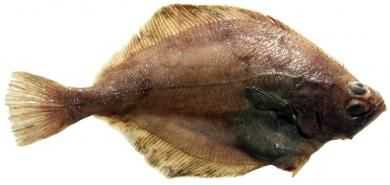Flathead Sole

Species Details
Hippoglossoides Elassodon
Pleuronectidae
Pleuronectiformes
Inshore, Nearshore, Offshore
2 - 3 lbs.
15" - 20"
Flathead Sole (Hippoglossoides elassodon) Description
The Flathead Sole is a right-eyed flatfish. It has a compressed body that looks oval in shape. The coloring on its upper surface can range from olive brown to reddish grey-brown, and its belly surface is white with some translucence. Dark splotches cover its upper side and its dorsal and anal fins.
This fish species is often mistaken for the Bering Flounder. The Bering Flounder matures more slowly and at a smaller size compared to the Flathead Sole. The Bering Flounder also favors colder water temperature.
Size and Diet
The Flathead Sole grows up to 20 inches in length and 3.4 pounds in weight, with the female being larger than the males at maturity. Females, though, live a shorter lifespan at 27 years compared to the males which are reported to live up to 30 years.
As it is a demersal fish species, the Flathead Sole normally consumes bottom dwellers, particularly zoobenthic invertebrates such as clams, worms and brittle stars. They also feed on fish and squid.
Interesting Facts about the Flathead Sole
- The Flathead Sole is an important food source for bigger fish such as the Pacific cod, Alaska pollock, arrowtooth flounder, Greenland turbot and Pacific halibut.
- The Flathead Sole settling in the southern part of its range reaches maturity at 2 to 3 years during which they spawn. Their northern counterparts, however, can only spawn at 6 years of age.
- The number of fish a female Flathead Sole can produce depends on its size. The number ranges from 72,000 to 600,000 eggs. They are large in size and are fertilized externally.
- The Flathead Sole is known to spawn actively from the months of February to April. They seek the deeper waters on the continental shelf to spawn.
- The Flathead Sole is among the top sole catches for fisheries in the United States, along with the Dover Sole and Rock Sole.
- The Flathead Sole’s flesh is very white, firm, and tender with a mild taste. Just like other flatfish, it can be cooked filleted. It is, however, not as high in healthy omega-3 compared to other white fish.
- In Alaska, the population of the Flathead Sole is considered abundant and is not prone to overfishing as yet.
Fishing Technique: How to Catch a Flathead Sole
Sole-fishing is available all year round. But it’s particularly fruitful during the summer months from June to September. While this fish species is a great game fish whatever time of day, it is especially exciting to catch them during low-light situations — twilight or well into the night are best as they are nocturnal feeders.
From the beach or rocks, anglers can go surfcasting, which is casting your hook weighted with bait behind the waves. Throw your hook far enough from the edge, then place your rod on your rod holder, then wait. Once you feel that a Flathead Sole has finally bit on your hook, you have to wait a few more seconds to make sure that the hook has been successful.
If anglers are using sea worms as live bait, they have to thread it all the way through a wormhole needle. Then place the tip of the needle on the hook’s tip, transferring the worm from the needle to the hook. If you’re using crabs, make sure to get soft crabs, or ones that are changing shells. You can find them under pebbles during low tide. For the crab to remain moving (and therefore increase its lure on the sole), you have to hook it in the legs with a single hook. Whichever bait you choose, make sure to use a smaller hook. An Aberdeen hook size 2 to 6 will do. As for rods, you can go light. Carp rods will generally work.
Habitat and Distribution
The Flathead Sole is native to the waters of the northern Pacific Ocean. It is found on the Sea of Japan, Sea of Okhotsk, and the Bering Sea. Its population is particularly abundant in Alaska, but it can also be found south of the state, along the west coast of North America to northern and central California, up to Point Reyes.
The juveniles of this fish species are found to settle and feed in shallow waters such as estuaries, bays, and nearshore coastal areas. As they mature, they swim to and settle on soft, silty, muddy and sandy ocean habitats that are less than 1000 feet in depth.
Spawning Flathead Sole will migrate from their spawning grounds in winter to feed in shallower waters during spring.







